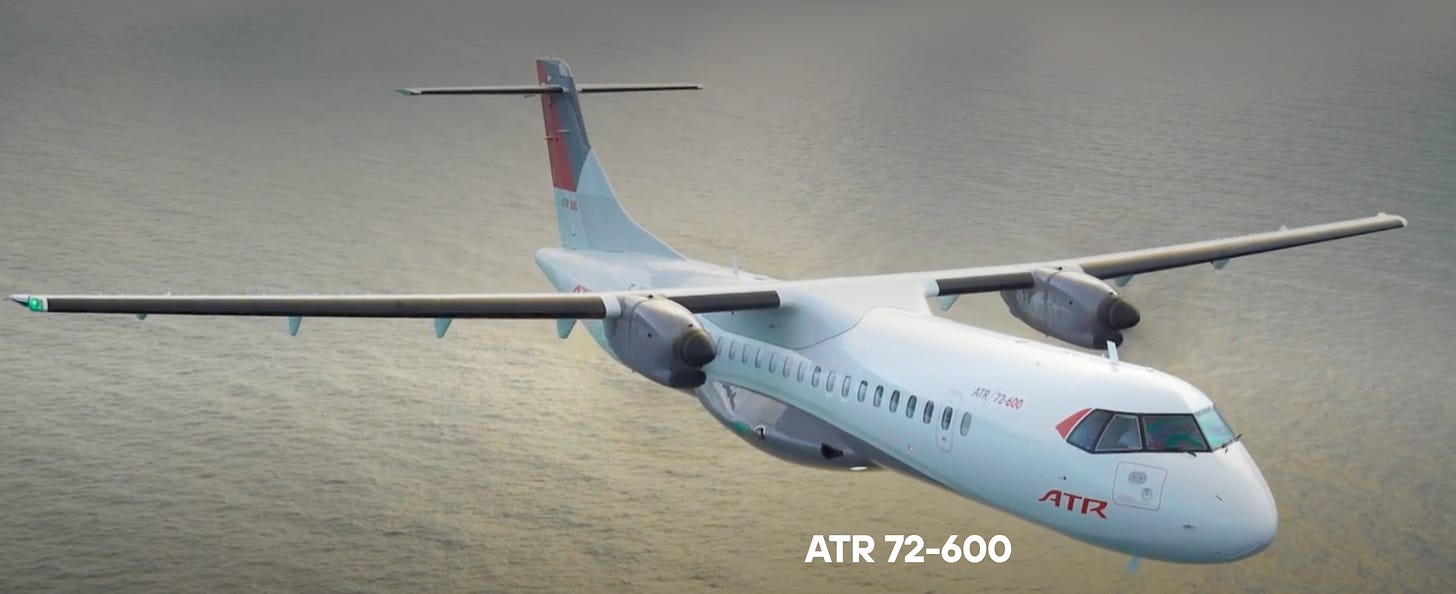The Tragic Crash in Brazil: Why Would an Airplane Fall From the Sky?
No one has answers. But here is a first round of questions, involving ‘icing’ and ‘flat spins.’
An ATR regional plane like the one that crashed in Brazil yesterday. (ATR site.)
Here, in Q-and-A style, are some basics about the crash of a Brazilian regional airliner yesterday, in which 61 passengers and crew are reported to have died.
As with all aviation tragedies, initial reports can be misleading, and it can take a long time for all relevant facts to emerge. But these are a few starting points:
Q. What happened?
The plane was an ATR 72-600, a well-known model made by a French-Italian consortium. The initials stand for “regional transport aircraft” in both languages: Avions de Transport Régional and Aerei da Trasporto Regionale.
The ATR-72 is a two-engine turboprop. Turboprop planes have turbine (jet) engines that turn propellers, rather than using sheer jet power. For shorter-haul and lower-altitude flights, they are cheaper and more efficient than the jet turbine engines familiar from big Boeing and Airbus models. That’s why so many regional airlines around the world use them.
As numerous horrifying phone-videos have recorded, the plane appeared not to dive toward the ground, while moving forward rapidly, but instead simply to fall, almost straight down, in a deadly pattern known in aviation as a “flat spin.” The involves a plane rotating slowly around its vertical axis, like a carousel, as gravity pulls it ever faster toward the earth. More data and details may eventually clarify what exactly happened, but on first impression the ending captured on video resembled a flat spin.
Q. What is a flat spin, and why does it matter?
Aviation training involves endless practice in recovering from “unusual attitudes”—stalls, spins, and other circumstances where the plane has departed from normal flight parameters. Of these the most threatening and hardest to recover from is the “flat spin.”
You can read many more details here, but the essence is this: Because an airplane in a flat spin has practically no forward airspeed, its normal “flight controls” have practically no effect. For instance: The ailerons on the wings normally bank the plane left and right by altering the airflow over each wing. With no airflow, the ailerons don’t work.
Similar problems limit the usual effect of the plane’s rudder and its elevator (the part of its tail that works with airflow to direct the plane’s nose up or down). Usually a crucial step in spin-recovery is to point the plane’s nose down. With little or no airflow over the tail, the pilot can’t do that.
Nearly every other in-flight anomaly has a prescribed recovery process. A flat spin can become unrecoverable.1
Q. How could a commercial airliner have entered a flat spin?
That is what investigators will try to explain. But it’s important to remember that the flat spin would be the last stage of the accident chain. Something else went wrong to start the process, and initial attention will focus on icing.
Q. What is icing, and how could it cause a disaster like this?
A flat spin is the flight condition most feared in aviation. Or one of them, along with onboard fire, engine failure at night over the ocean or the mountains, etc. The flight hazards most feared are thunderstorms, and “airframe icing.”
An airplane’s wings, nose, windows, tail, engine intakes, propellers, and other surfaces can become covered with ice under specific in-air circumstances. This can happen when (a) there is “visible moisture,” aka being inside a cloud; and (b) the air temperature is around freezing, or as much as -20C below. In these circumstances, ice can build up with terrifying quickness. Suddenly the windshield is iced over. (Airliner windshields are heated, so the pilots can see.) And suddenly the pilots are trying to control a big airborne chunk of ice.
Airframe icing brings planes down for two main reasons. One is that it changes the shape of the airplane, especially its wings. Every millimeter of an airplane’s design is configured for the airflow that will maximize lift and speed. That’s why we have the term aerodynamic. As ice builds up, suddenly the shape is different, and the wings provide less and less lift.
The other problem with taking on a layer of ice is that it makes the airplane heavier.
An ice-covered airplane has less power, and a greater load. Eventually it comes down.
Q. And why are we talking about icing in this case?
Because of numerous reports suggesting “severe” icing in the vicinity of this crash. Icing reports come in several varieties, of which severe is the worst. It means accumulations that various anti-icing systems can’t keep up with.
Q. But why would icing lead to a ‘flat spin’?
Again the investigators will look into this. But one well-known scenario involves use of the autopilot.
When a plane is on autopilot while entering icing conditions, it can develop a serious “out of trim” condition. That is: the plane’s aerodynamics are becoming worse and worse, as the ice builds up. All the while, the autopilot is fighting to keep the plane at a designated altitude.
If the pilots were hand-flying, they would realize this, because they’d have to keep pulling up harder and harder on the yoke. But the autopilot masks this “out of trim” condition until suddenly the strain on it is too great, and the autopilot fails or switches itself off. Then the pilots are suddenly fighting a plane that’s in a stall or spin. This could begin the accident chain whose conclusion we see on the videos.
Q. Should I worry about this on my next flight?
On a long-haul airliner, No.




